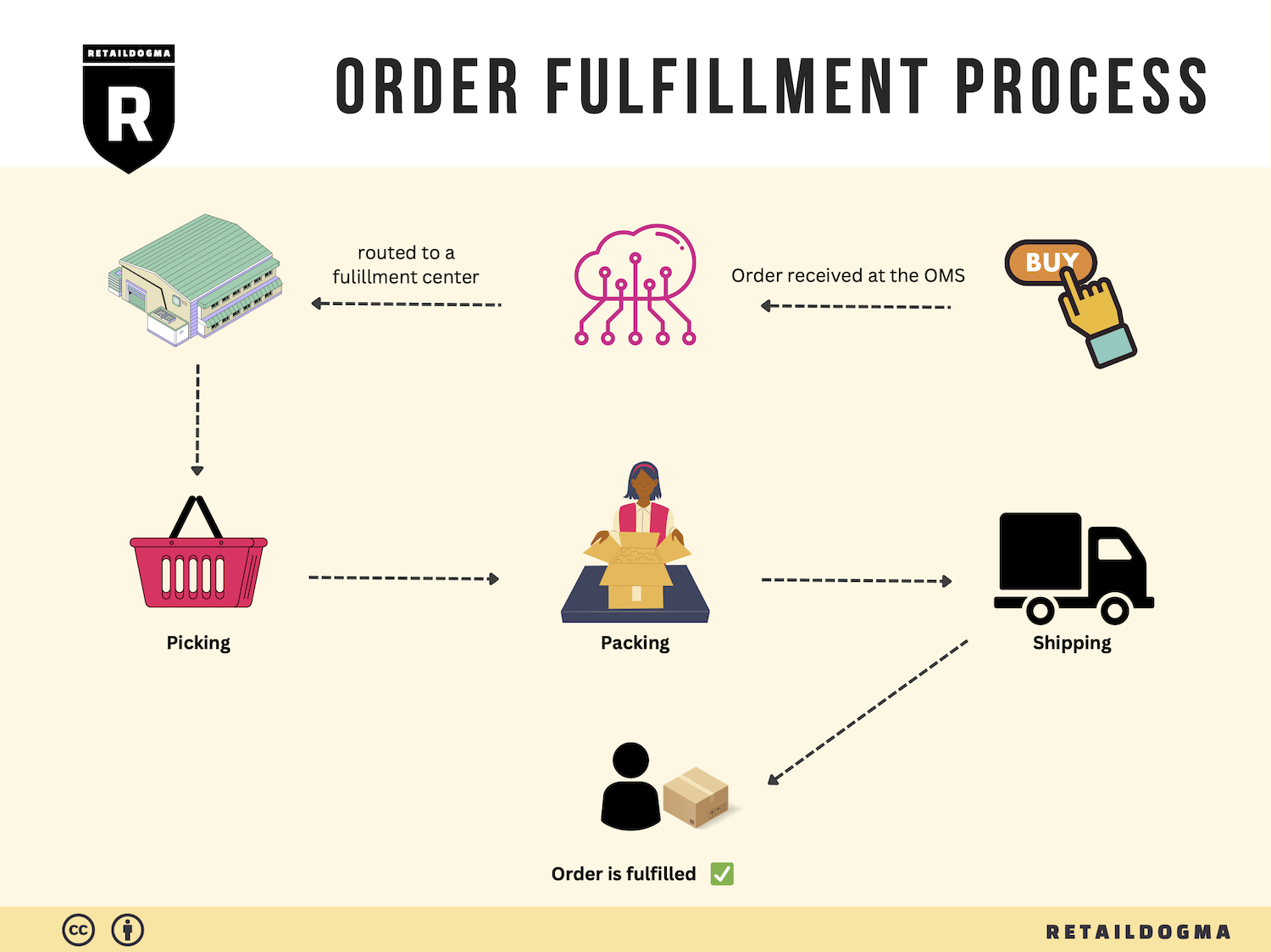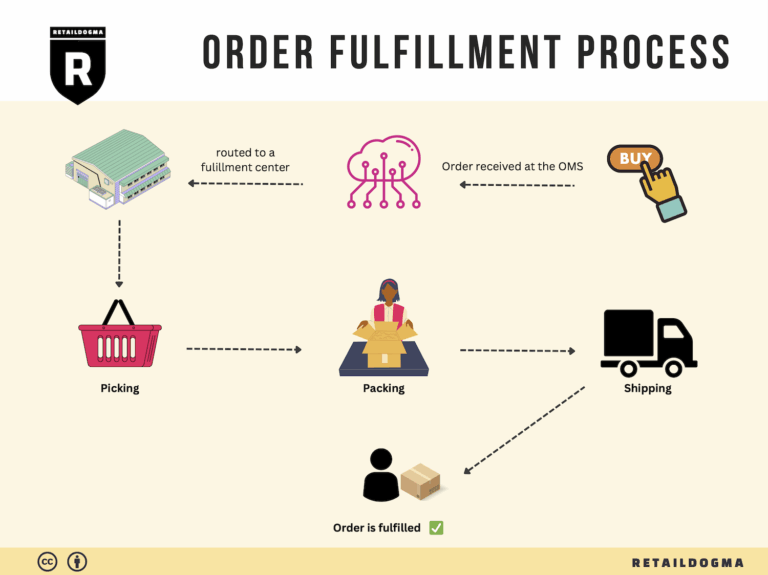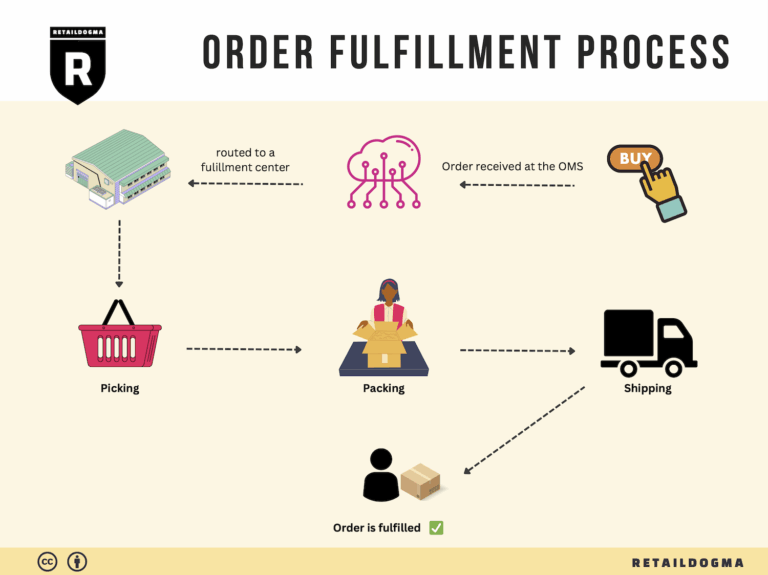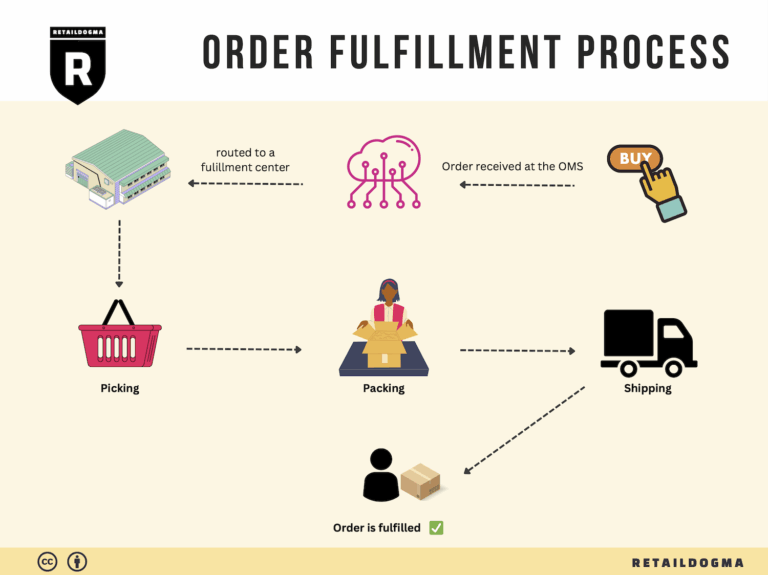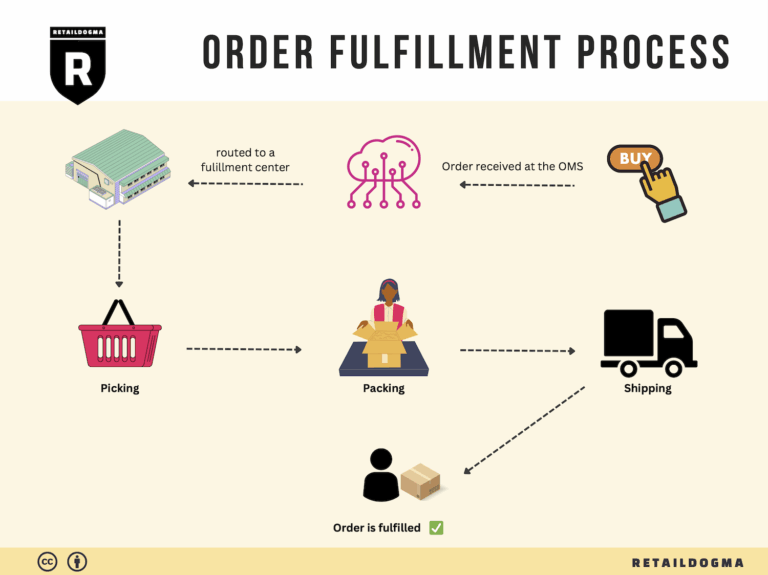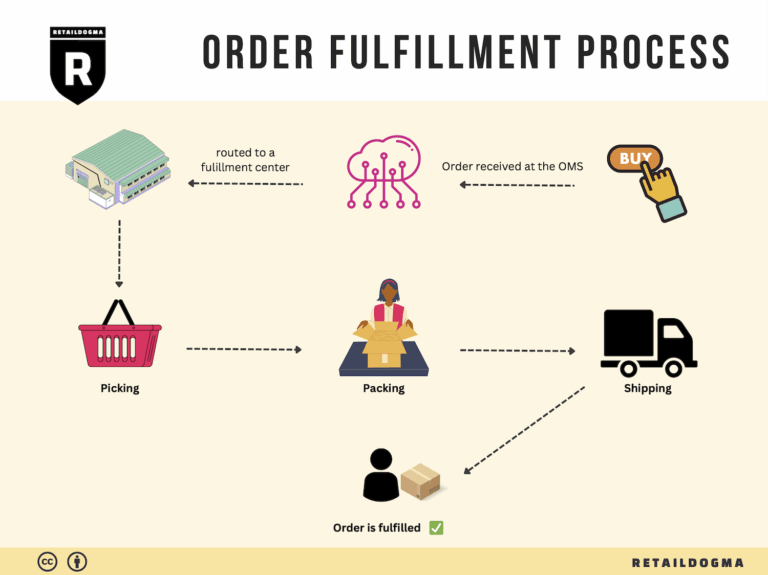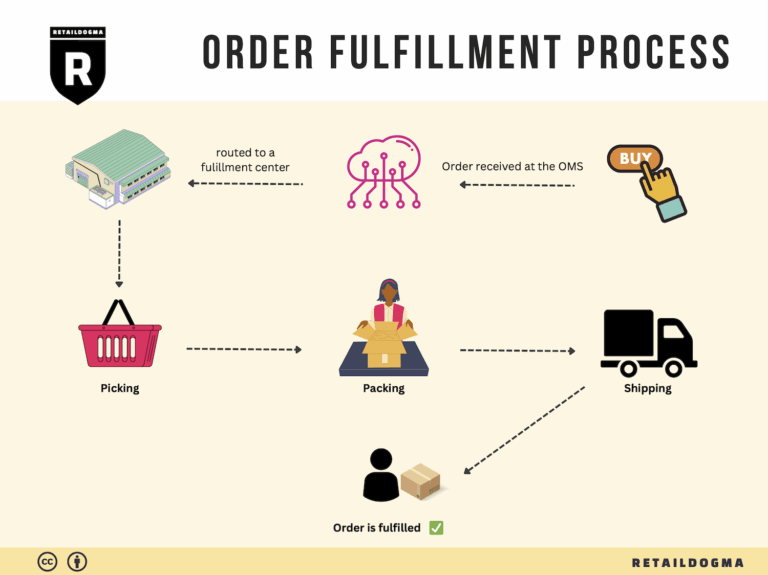What Is A Fulfillment Center? A Complete Guide (2025)
What is E-commerce Fulfillment? An Introduction for Growing Businesses
As e-commerce businesses expand, many owners find themselves grappling with the complexities of packing and shipping orders. The excitement of increased sales can quickly turn to overwhelm as the logistics of fulfillment become more intricate. This is a common pain point for growing online businesses, which often struggle to balance order management, inventory control, and timely delivery while maintaining high customer satisfaction.
Understanding Fulfillment
At its core, e-commerce fulfillment refers to the process of getting a product into the hands of a customer. It encompasses a range of activities, from receiving inventory and storing products to processing orders, picking and packing items, and finally shipping them out. For many businesses, effective fulfillment is crucial to sustaining growth and maintaining a competitive edge in the market.
What This Guide Covers
This guide aims to demystify e-commerce fulfillment for business owners, operations managers, and entrepreneurs looking to scale their logistics. We will explore different fulfillment models, including Third-Party Logistics (3PL) and Fulfillment by Amazon (FBA), highlighting the benefits and drawbacks of each. Understanding these models will help you determine which approach aligns best with your business needs.
We will also delve into the core services involved in fulfillment, such as inventory management, order processing, and shipping solutions. This understanding will empower you to make informed decisions about your logistics strategy.
Choosing the right fulfillment partner is another critical aspect we will address. We’ll provide insights into what to look for in a fulfillment provider, including technology capabilities, reliability, and customer service. Making a well-informed choice can significantly impact your operational efficiency and customer experience.
Lastly, we will discuss pricing structures associated with fulfillment services. Knowing the costs involved will help you budget effectively and identify the most cost-efficient solutions for your business.
Our Goal
The ultimate goal of this guide is to empower e-commerce businesses to make smart, strategic decisions about their logistics. By equipping you with the knowledge and tools necessary to navigate the complexities of fulfillment, we hope to alleviate some of the challenges associated with scaling your operations. With the right fulfillment strategy in place, you can focus on what you do best: growing your business and delighting your customers.
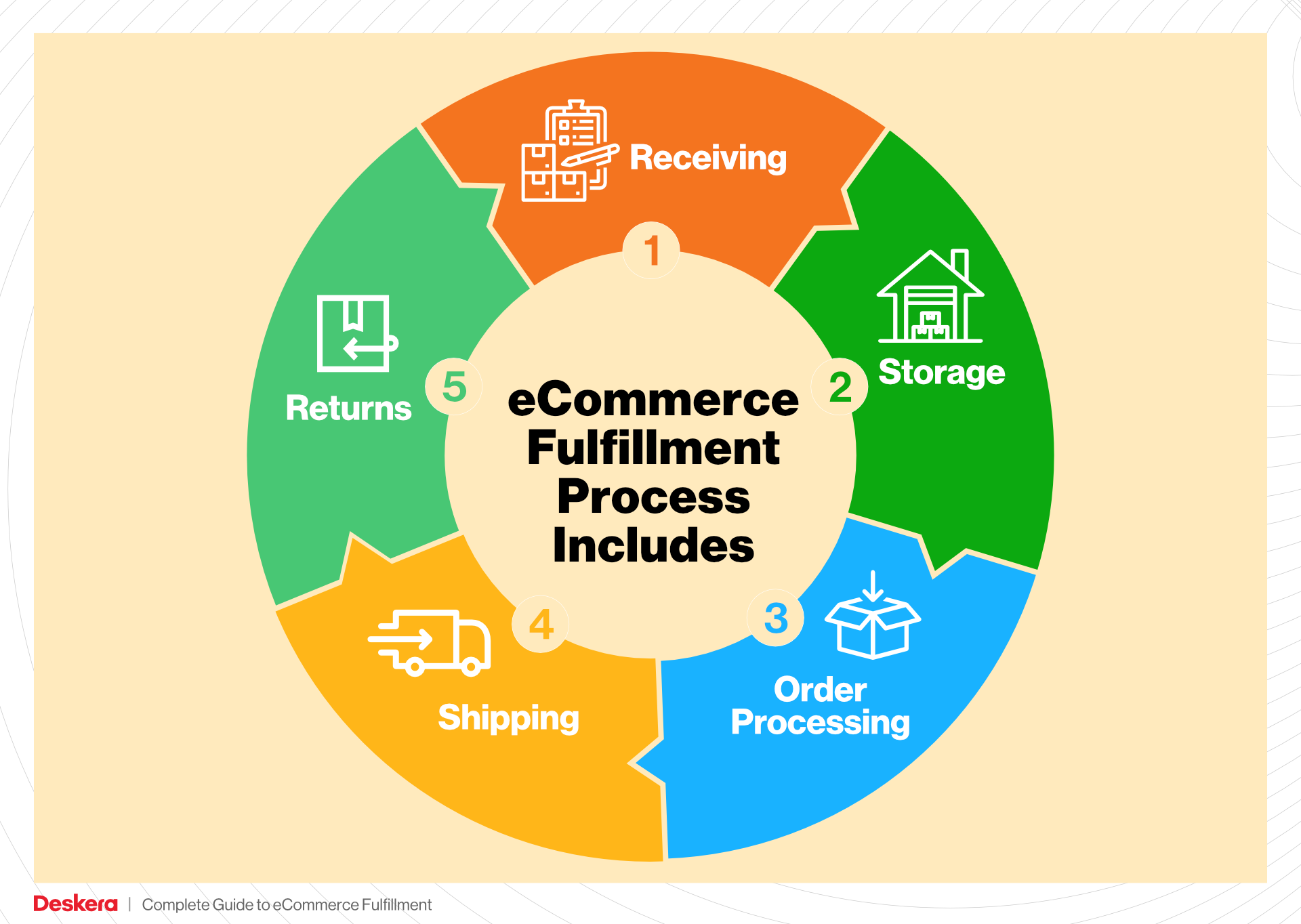
What You’ll Learn In This Guide
- What is E-commerce Fulfillment? An Introduction for Growing Businesses
- The Order Fulfillment Process: From ‘Buy’ Button to Customer’s Door
- Comparing Fulfillment Models: In-House vs. 3PL vs. Dropshipping
- A Deep Dive into Amazon FBA: Pros, Cons, and Who It’s For
- Core Services Offered by Fulfillment Centers
- How to Choose a Fulfillment Partner: A 6-Point Checklist
- Understanding Fulfillment Pricing: A Breakdown of Common Fees
- Frequently Asked Questions (FAQs) about Fulfillment
- Conclusion: Is Outsourcing Fulfillment the Right Move for Your Business?
- Important Disclaimer
The Order Fulfillment Process: From ‘Buy’ Button to Customer’s Door
1. Receiving Inventory
The order fulfillment process begins with receiving inventory, which is crucial for maintaining a seamless supply chain. When products arrive at the fulfillment center, they must be checked against the purchase orders to ensure accuracy. This step often involves the use of Stock Keeping Units (SKUs), unique identifiers assigned to each product, which help streamline the inventory management process.
Upon receipt, inventory is inspected for quality and quantity. Any discrepancies—such as damaged goods or incorrect quantities—must be addressed immediately, as they can disrupt the entire fulfillment process. Accurate receiving not only prevents stockouts but also builds a solid foundation for efficient warehouse operations. Ensuring that products are correctly logged into the system allows for better tracking and inventory management, which is vital as businesses scale.
2. Warehouse Storage
Once inventory is received and verified, it is stored in the warehouse. This step is vital for maximizing space utilization and ensuring that products are accessible for future orders. Effective storage strategies often involve categorizing products based on their SKU and organizing them in a way that minimizes retrieval time.
Key terms associated with warehouse storage include “slotting,” which refers to the strategic placement of products within the warehouse to enhance picking efficiency. For example, fast-moving items might be placed closer to packing areas, while slower-moving items can be stored further away. Proper warehouse organization not only facilitates quicker order fulfillment but also reduces labor costs and improves overall operational efficiency.
3. Order Picking
The next step in the fulfillment process is order picking, where items are gathered from their storage locations to fulfill customer orders. This step is critical as it directly impacts order accuracy and speed. Businesses often utilize “pick lists,” which are generated based on incoming orders, detailing the items and their respective locations within the warehouse.
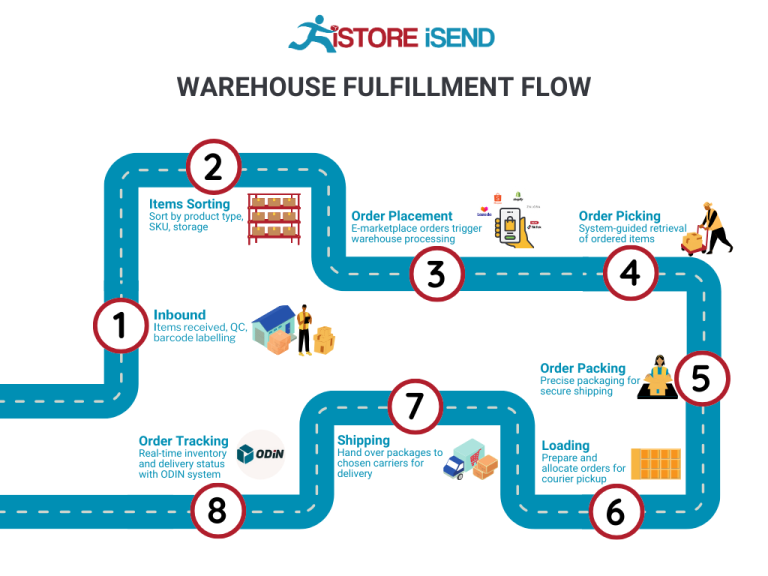
Efficient picking strategies, such as batch picking (where multiple orders are picked simultaneously) or zone picking (where pickers are assigned specific areas), can significantly enhance productivity. The faster and more accurately items are picked, the quicker the orders can be processed, leading to improved customer satisfaction. Investing in technology, such as barcode scanners or mobile picking solutions, can also streamline this process, reducing errors and time spent on order fulfillment.
4. Order Packing
Once the items are picked, the next step is order packing. This is where the products are carefully packed into boxes or other containers for shipment. Effective packing is essential not only for protecting the items during transit but also for optimizing shipping costs.
Key considerations during packing include the use of “packing slips,” which are documents that outline the contents of the package and serve as a reference for both the warehouse team and the customer. Proper packing techniques, such as using appropriate cushioning materials, can prevent damage and returns, which can be costly. Additionally, businesses should leverage technology to automate packing processes, ensuring accuracy and efficiency, especially as order volumes increase.
5. Shipping & Delivery
The final step in the order fulfillment process is shipping and delivery. Once orders are packed, they are labeled and prepared for dispatch. This stage is crucial as it determines how quickly and efficiently products reach the customer’s door.
Shipping methods can vary based on the destination and urgency of the order, with terms like “last-mile delivery” referring to the final leg of the shipping process. Businesses must choose reliable shipping partners and consider factors such as shipping costs and delivery times to optimize customer satisfaction. Implementing tracking systems allows customers to monitor their orders, enhancing transparency and trust. As e-commerce continues to grow, companies that invest in efficient shipping and delivery solutions will have a competitive edge in the marketplace.
By understanding and optimizing each step of the order fulfillment process, e-commerce businesses can significantly enhance their operational efficiency and customer satisfaction, ultimately driving growth and scalability in their operations.
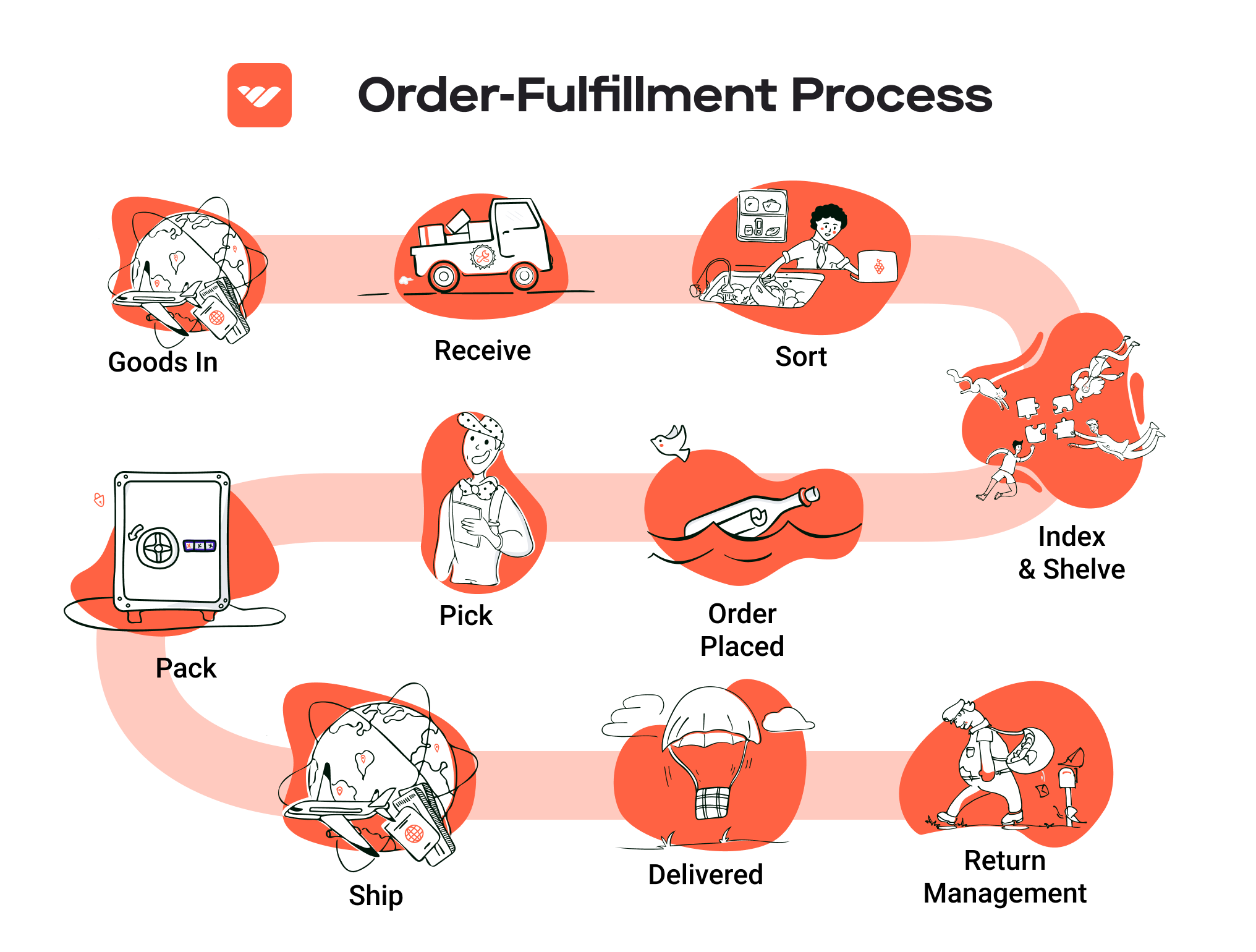
Comparing Fulfillment Models: In-House vs. 3PL vs. Dropshipping
Fulfillment Model Comparison Table
| Model | Who Handles Inventory | Best For (Business Stage) | Key Advantage | Key Disadvantage |
|---|---|---|---|---|
| In-House Fulfillment | Business (Own Warehouse) | Established businesses with steady sales | Full control over inventory and fulfillment processes | High overhead costs and resource demands |
| Third-Party Logistics (3PL) | Third-party provider | Growing businesses looking to scale | Reduced operational burden and access to expertise | Less control over inventory management and fulfillment speed |
| Dropshipping | Supplier | Startups and businesses with limited capital | Minimal upfront investment and low risk | Lower profit margins and reliance on supplier reliability |
In-House Fulfillment
In-house fulfillment refers to a model where a business manages its own inventory and logistics operations. This often involves maintaining a warehouse, hiring staff for order picking and packing, and managing shipping logistics. This model is best suited for established businesses that have a steady volume of sales and can justify the investment in infrastructure and personnel. One of the primary advantages of in-house fulfillment is the complete control it offers over the entire inventory and fulfillment process. Businesses can implement custom processes, quality control measures, and shipping options tailored to their specific needs. However, this model can come with significant overhead costs, including warehousing expenses, labor costs, and investment in technology for inventory management. Additionally, as sales volumes fluctuate, businesses may find it challenging to maintain efficiency, leading to potential waste of resources.
Third-Party Logistics (3PL)
Third-party logistics (3PL) providers offer outsourced logistics services, allowing businesses to delegate inventory management, warehousing, and fulfillment to a specialized partner. This model is particularly beneficial for growing businesses that wish to scale operations without the burden of managing logistics themselves. By leveraging a 3PL, businesses can access advanced logistics technology and expertise, benefiting from optimized shipping rates and fulfillment strategies. Additionally, 3PLs often have established networks that can enhance delivery speed and reliability. However, a key disadvantage of this model is the reduced control over the fulfillment process. Businesses must rely on the 3PL to handle inventory accurately and efficiently, which can lead to challenges in maintaining service quality, especially if the provider does not align with the business’s operational standards. This model can also introduce complexities in communication and data sharing between the business and the 3PL.
Dropshipping
Dropshipping is a fulfillment method where a business sells products without holding inventory. Instead, when a customer places an order, the retailer purchases the item from a third-party supplier who then ships it directly to the customer. This model is especially appealing for startups and entrepreneurs with limited capital, as it requires minimal upfront investment and reduces financial risk. The primary advantage of dropshipping is the low barrier to entry; businesses can offer a wide range of products without the need for inventory management or warehousing. However, dropshipping comes with its challenges, including lower profit margins due to reliance on suppliers for fulfillment. Furthermore, businesses are often at the mercy of their suppliers’ reliability and shipping times, which can affect customer satisfaction and brand reputation. Additionally, the lack of control over inventory can lead to stockouts or delays, making it essential for dropshippers to choose reliable suppliers and maintain clear communication.
Conclusion
Choosing the right fulfillment model is critical for the success of an e-commerce business. Each model—In-House Fulfillment, Third-Party Logistics, and Dropshipping—has its own set of advantages and disadvantages that can significantly impact operational efficiency, customer satisfaction, and overall profitability. Businesses must assess their current stage, operational capacity, and long-term goals to determine which model aligns best with their strategic objectives. In doing so, they can create a fulfillment strategy that not only meets their immediate needs but also supports scalable growth in the future.
A Deep Dive into Amazon FBA: Pros, Cons, and Who It’s For
What is Fulfillment by Amazon (FBA)?
Fulfillment by Amazon (FBA) is a service that allows e-commerce sellers to store their products in Amazon’s fulfillment centers. When a customer orders a product, Amazon takes care of storage, packaging, and shipping, as well as customer service and returns. This service is particularly appealing for sellers looking to scale their operations without the overhead associated with managing their own warehouses and logistics.
The process is straightforward: sellers send their inventory to Amazon’s warehouses, and once the products are listed on Amazon, they become eligible for Amazon Prime and other Amazon services. Sellers benefit from Amazon’s extensive logistics network, which includes fast shipping options and robust customer service.
How Does FBA Work?
-
Setup: Sellers create an Amazon seller account and register for FBA. They prepare their products according to Amazon’s guidelines, which include labeling and packaging requirements.
-
Shipping to Amazon: Sellers send their inventory to designated Amazon fulfillment centers. Amazon provides guidelines on how to ship products, including the quantity and locations of warehouses.
-
Storage: Once received, Amazon stores the products in their fulfillment centers. Sellers can track their inventory levels through the Amazon Seller Central dashboard.
-
Order Fulfillment: When a customer places an order, Amazon picks, packs, and ships the product directly to the customer. This process is typically quick, allowing for same-day or next-day shipping, particularly for Prime members.
-
Customer Service: Amazon handles all customer service inquiries and returns related to FBA products, freeing sellers from these responsibilities.
-
Payment: Sellers receive payments for their sales after Amazon deducts applicable fees, which vary based on product category, size, and weight.
Pros of Fulfillment by Amazon (FBA)
1. Prime Eligibility
One of the most significant advantages of FBA is that products become eligible for Amazon Prime, which can dramatically increase visibility and sales. Prime members are known to spend more and prefer products that offer fast shipping options.
2. Customer Trust
Using FBA lends credibility to sellers, as customers often trust Amazon’s fulfillment service. This trust can lead to higher conversion rates and lower return rates, as buyers feel more secure purchasing products backed by Amazon’s customer service.
3. Multi-Channel Fulfillment
FBA is not limited to Amazon’s marketplace. Sellers can use FBA to fulfill orders from their own websites or other e-commerce platforms. This multi-channel fulfillment capability allows businesses to streamline logistics across various sales channels while leveraging Amazon’s logistics expertise.
4. Scalability
FBA allows businesses to scale without the burden of managing warehousing and shipping logistics. As sales increase, sellers can simply send more inventory to Amazon, making it easier to grow their operations.
5. Automated Logistics Management
With FBA, sellers can automate many aspects of logistics, including inventory management, shipping, and customer service. This automation can save time and reduce operational complexities.
Cons of Fulfillment by Amazon (FBA)
1. High Fees
FBA comes with a variety of fees, including storage fees, fulfillment fees, and additional charges for long-term storage. These costs can add up, particularly for sellers with low-margin products or those with slow-moving inventory.
2. Strict Inventory Rules
Amazon has stringent inventory management policies. Sellers must monitor their inventory levels closely to avoid stockouts or excess stock, which can incur additional fees. Failure to comply with these rules can result in penalties or account suspension.
3. Commingling Risks
FBA products are often commingled, meaning that inventory from different sellers is stored together. While this can enhance efficiency, it also poses risks. If a defective or counterfeit product is sent to a customer, it can harm the reputation of all sellers involved.
4. Loss of Control
When using FBA, sellers relinquish control over the fulfillment process. This can be concerning for businesses that want to maintain a specific brand experience or have unique packaging requirements.
5. Limited Customization
Sellers are limited in their ability to customize packaging and branding when using FBA. For businesses that emphasize unique branding, this can be a significant drawback.
Who is FBA Best For?
Fulfillment by Amazon is best suited for:
-
Small to Medium-Sized Businesses: Sellers who want to scale quickly without investing heavily in logistics infrastructure will benefit from FBA’s capabilities.
-
High-Volume Sellers: Businesses with a steady sales volume and a diverse product range can maximize the benefits of FBA by reducing fulfillment costs and improving delivery times.
-
Retail Arbitrage and Resellers: Individuals looking to resell products can leverage FBA to handle logistics, allowing them to focus on sourcing and sales.
-
Brands Expanding into E-Commerce: Established brands looking to enter the e-commerce space can use FBA to tap into Amazon’s vast customer base and logistics network.
-
Sellers with Seasonal Products: Businesses that experience fluctuations in demand can utilize FBA to manage inventory more effectively without the overhead of a dedicated warehouse.
In conclusion, while Fulfillment by Amazon offers a range of benefits that can significantly enhance an e-commerce business’s logistics and customer service, it’s crucial for sellers to weigh these advantages against the associated costs and risks. Understanding whether FBA aligns with your business model and growth strategy is key to making an informed decision.
Core Services Offered by Fulfillment Centers
Inventory Management & Warehousing
Inventory management and warehousing are foundational services provided by fulfillment centers that play a critical role in the e-commerce supply chain. This service involves the systematic tracking and management of stock levels, storage locations, and inventory turnover. Fulfillment centers utilize advanced technology, such as inventory management software, to provide real-time visibility into stock availability and to automate reordering processes.
Benefits:
1. Optimized Stock Levels: By leveraging data analytics, fulfillment centers can maintain optimal inventory levels, ensuring that businesses do not overstock or run out of essential products. This balance helps in reducing holding costs while maximizing sales opportunities.
2. Efficient Space Utilization: Fulfillment centers are designed to use space efficiently, often employing vertical storage solutions and advanced shelving systems. This allows businesses to store a wide range of products without needing extensive warehouse space of their own.
3. Scalability: As e-commerce businesses grow, their inventory needs can fluctuate significantly. Fulfillment centers can easily scale storage capacity up or down based on demand, providing flexibility that is often challenging for businesses to manage independently.
Pick and Pack Services
Pick and pack services refer to the process of selecting (picking) items from inventory to fulfill customer orders and then packaging (packing) those items appropriately for shipment. This service is crucial for ensuring that orders are fulfilled accurately and efficiently.
Benefits:
1. Accuracy and Speed: Fulfillment centers employ trained staff and sophisticated technology to ensure that orders are picked accurately, which reduces the likelihood of errors. Faster processing times lead to quicker dispatch, enhancing customer satisfaction.
2. Custom Packaging Options: Many fulfillment centers offer customizable packaging solutions that can include branding elements, which help businesses present a professional image to their customers. This is particularly important for building brand identity in a competitive e-commerce landscape.
3. Labor Efficiency: By outsourcing pick and pack operations, e-commerce businesses can focus their workforce on core activities, such as marketing and customer service, rather than logistics. This can lead to better overall operational efficiency and productivity.
Kitting and Assembly
Kitting and assembly services involve grouping multiple products into a single package or creating a finished product from individual components. This service is particularly beneficial for businesses offering bundled products, promotional kits, or complex items requiring assembly before shipping.
Benefits:
1. Streamlined Processes: By having fulfillment centers handle kitting and assembly, businesses can streamline their logistics processes, reducing the time it takes to prepare orders for shipping. This is especially advantageous during peak seasons when demand surges.
2. Enhanced Customer Experience: Kitting allows businesses to offer unique product combinations that can enhance customer satisfaction and encourage larger purchases. For example, a tool manufacturer might sell a kit that includes multiple related tools, providing added value to the customer.
3. Reduced Returns: Proper assembly and kitting can reduce the chances of product returns due to missing parts or incorrect configurations. This not only saves costs associated with returns but also improves customer trust and loyalty.
Returns Management (Reverse Logistics)
Returns management, or reverse logistics, is the process of handling product returns efficiently. This service includes receiving returned items, inspecting them, restocking them if applicable, and managing any necessary repairs or refurbishments.
Benefits:
1. Customer Retention: A streamlined returns process can significantly enhance customer satisfaction. When customers know that returning products is easy and hassle-free, they are more likely to make repeat purchases and recommend the business to others.
2. Cost Control: Effective returns management can help businesses minimize losses from returned products. By efficiently processing returns and determining the best course of action for each item (restocking, refurbishing, or recycling), businesses can recover value from returned inventory.
3. Data Insights: Fulfillment centers can provide valuable insights into return trends, helping businesses identify common issues with products. This information can inform product development, quality control, and customer service strategies, ultimately leading to improved product offerings and customer experiences.
In summary, partnering with a fulfillment center can provide e-commerce businesses with essential services that enhance operational efficiency, customer satisfaction, and scalability. By leveraging these core services, businesses can focus on growth and innovation while ensuring their logistics needs are met effectively.
How to Choose a Fulfillment Partner: A 6-Point Checklist
Location & Warehouse Network
Importance: The geographical location of your fulfillment partner’s warehouses can significantly affect shipping times and costs. A partner with strategically placed warehouses can ensure faster delivery to your customers, which is crucial in today’s fast-paced e-commerce environment.
Questions to Ask:
– Where are your warehouses located, and how many do you have?
– Do you have warehouses in regions where my target customers are concentrated?
– How do you handle shipping logistics to ensure timely deliveries?
Technology & Integrations
Importance: In an era where data drives decision-making, the technology used by your fulfillment partner is paramount. Advanced systems can provide real-time inventory tracking, order management, and integration with your e-commerce platform, enhancing operational efficiency.
Questions to Ask:
– What fulfillment software do you use, and how does it integrate with major e-commerce platforms?
– Can you provide real-time inventory updates and tracking for my orders?
– How do you handle system outages or technical issues?
Specializations (e.g., Cold Storage, Oversized Items)
Importance: Depending on your product offerings, specific fulfillment capabilities may be necessary. If you sell perishable goods, for instance, your partner must have cold storage facilities. Similarly, if your products are large or require special handling, ensure your partner has the necessary expertise and equipment.
Questions to Ask:
– What special handling capabilities do you offer (e.g., cold storage, hazardous materials)?
– Do you have experience handling products similar to mine?
– What processes do you have in place for quality control?
Scalability & Capacity
Importance: As your business grows, your fulfillment needs will evolve. Your partner must be able to scale operations efficiently to accommodate increased order volumes without compromising service quality.
Questions to Ask:
– How do you handle peak seasons or sudden spikes in demand?
– What is your capacity for fulfilling orders, and can you provide examples of how you’ve scaled for other clients?
– Are there any limitations on the types or volumes of products you can handle?
Pricing and Contracts
Importance: Understanding the pricing structure and contract terms is crucial for budgeting and financial planning. Transparent pricing helps avoid unexpected costs down the line.
Questions to Ask:
– What is your pricing model (e.g., per order, per item, storage fees)?
– Are there any additional fees I should be aware of (e.g., for returns, storage, or handling)?
– What are the contract terms, and is there flexibility if my needs change?
Customer Support & Reviews
Importance: A responsive customer support team can be invaluable in resolving issues swiftly, ensuring smooth operations. Additionally, understanding the experiences of other businesses can provide insight into the reliability and quality of the partner.
Questions to Ask:
– What customer support channels do you offer (e.g., phone, email, live chat)?
– Can you provide references or case studies from current or past clients?
– How do you handle disputes or issues that arise during the fulfillment process?
Conclusion
Choosing the right fulfillment partner is a critical step in scaling your e-commerce business. By evaluating potential partners through this checklist, you can ensure that you select a partner that aligns with your operational needs and growth objectives. The right partner will not only enhance your logistics capabilities but also contribute to a superior customer experience. Taking the time to ask these questions will help you make an informed decision that supports your long-term success.
Understanding Fulfillment Pricing: A Breakdown of Common Fees
Initial Setup Fees
Initial setup fees are the costs associated with onboarding your business to a fulfillment center. These fees can cover a variety of services, including account creation, software integration, and the initial configuration of your inventory system. Typically, fulfillment centers will charge a flat fee for this service, which can range from a few hundred to several thousand dollars, depending on the complexity of your needs and the scale of your operations.
The setup fee may also include training for your staff on how to use the fulfillment center’s systems effectively. It’s essential to clarify what is included in the setup fee, as some fulfillment centers may charge additional fees for software customizations or ongoing support.
Receiving Fees
Receiving fees are charged when your inventory arrives at the fulfillment center. This fee covers the labor and resources required to unload, inspect, and log your products into the system. Typically, receiving fees can be calculated based on the number of pallets or boxes received, with costs varying by the fulfillment center’s operational efficiency and location.
For instance, a common pricing structure may be a fixed fee per pallet received, often ranging from $15 to $50. Some fulfillment centers may also charge additional fees for handling products that require special care or are oversized. To manage costs effectively, it’s advisable to consolidate shipments to minimize the frequency of receiving fees.
Storage Fees (per pallet/bin)
Storage fees are recurring costs associated with keeping your inventory in the fulfillment center. These fees are typically charged on a monthly basis and can be calculated on a per-pallet or per-bin basis. Rates may vary significantly depending on the location of the fulfillment center, with urban centers often charging higher fees due to increased demand for space.
Common rates range from $10 to $30 per pallet per month. Additionally, some fulfillment centers offer tiered pricing structures, where the cost per pallet decreases as the volume increases. It’s essential to monitor your inventory turnover and consider seasonal fluctuations, as higher storage fees can erode profit margins if products are not moving quickly.
Pick & Pack Fees (per item/order)
Pick and pack fees are charged for the labor involved in retrieving items from storage and preparing them for shipment. This fee is typically calculated per item picked and packed, with costs ranging from $0.50 to $3.00 per item, depending on the complexity of the order and the efficiency of the fulfillment center.
Some fulfillment centers may also offer a flat fee for each order, which can be beneficial for businesses with larger orders containing multiple items. It’s crucial to understand how these fees are structured, as they can significantly impact your overall fulfillment costs, especially if you have a diverse product range with varying order sizes.
Shipping Fees
Shipping fees cover the cost of delivering your products to customers. These fees can vary widely based on several factors, including package dimensions, weight, destination, and the shipping method selected (e.g., standard, expedited, or same-day delivery). Fulfillment centers often pass on their negotiated shipping rates from carriers like UPS, FedEx, or USPS, which can provide cost savings compared to retail shipping rates.
When calculating shipping fees, it’s important to consider not only the cost of shipping but also any additional handling fees that may apply. Some fulfillment centers may charge a fee for specific packaging materials or for preparing international shipments. Businesses should actively negotiate shipping rates with their fulfillment partners to ensure they are getting competitive pricing.
Tips for Getting an Accurate Quote
To obtain an accurate fulfillment pricing quote, consider the following tips:
-
Be Transparent About Your Needs: Provide detailed information about your inventory volume, types of products, and expected order sizes. This helps fulfillment centers tailor their quote to your specific requirements.
-
Request a Breakdown of Fees: Ask for a detailed breakdown of all potential fees, including setup, receiving, storage, pick & pack, and shipping. Understanding each component allows for better budget planning.
-
Compare Multiple Providers: Don’t settle for the first quote you receive. Compare offers from several fulfillment centers to identify the best value for your business.
-
Inquire About Discounts: Many fulfillment centers offer discounts for higher volumes or long-term contracts. Inquire about these options to optimize your costs.
-
Evaluate Contract Terms: Carefully review the terms of service and cancellation policies. Flexibility in your contract can save you money if your business needs change.
By taking these steps, you can ensure that you receive a comprehensive and accurate quote that aligns with your operational goals and budget.
Frequently Asked Questions (FAQs) about Fulfillment
1. What is a fulfillment center?
A fulfillment center is a specialized facility that manages the storage, packing, and shipping of products on behalf of e-commerce businesses. Unlike traditional warehouses that primarily store inventory, fulfillment centers focus on the entire order fulfillment process, ensuring that products are picked, packed, and shipped to customers efficiently and accurately.
2. How does Fastenal’s fulfillment center operate?
Fastenal’s fulfillment centers leverage an omnichannel strategy to streamline order processing and distribution. They utilize a network of over 1,700 physical branches that support e-commerce transactions. This allows for efficient inventory management, rapid order fulfillment, and enhanced customer service by integrating online and offline operations.
3. What services does Fastenal offer through its fulfillment center?
Fastenal provides a range of services through its fulfillment center, including order processing, inventory management, shipping, and logistics solutions. They also offer specialized services such as OnSite inventory management and vending solutions, which help businesses maintain optimal stock levels and improve operational efficiency.
4. What is the difference between a warehouse and a fulfillment center?
The primary difference lies in their functions. A warehouse is mainly used for storage and inventory management, while a fulfillment center focuses on processing customer orders. Fulfillment centers are equipped to handle picking, packing, and shipping, often featuring technology to track orders and manage inventory in real-time.
5. What is a Third-Party Logistics Provider (3PL)?
A Third-Party Logistics Provider (3PL) is a company that provides outsourced logistics services, including warehousing, transportation, and fulfillment. Businesses partner with 3PLs like Fastenal to leverage their expertise, technology, and infrastructure, allowing them to scale operations without investing heavily in their own logistics capabilities.
6. How much do fulfillment services cost?
Fulfillment service costs can vary widely based on several factors, including order volume, storage space, and specific services required. Generally, costs may include storage fees, pick and pack fees, shipping costs, and additional service charges. It’s advisable for businesses to request quotes from fulfillment providers to understand pricing tailored to their specific needs.
7. How can Fastenal improve my e-commerce fulfillment process?
Fastenal enhances e-commerce fulfillment through its integrated approach, combining technology, inventory management, and logistics expertise. By utilizing their extensive network of branches, Fastenal can facilitate faster shipping times, improve order accuracy, and provide real-time inventory visibility, all of which can lead to a better customer experience.
8. What technologies does Fastenal use in its fulfillment operations?
Fastenal employs advanced technologies to optimize its fulfillment operations, including data analytics for inventory management, automated order processing systems, and tracking software to monitor shipments. These technologies enhance efficiency and provide businesses with insights into their inventory and order fulfillment performance.
9. Can Fastenal handle large volume orders?
Yes, Fastenal is equipped to handle large volume orders due to its extensive network of fulfillment centers and branches. Their scalable operations allow them to efficiently process bulk orders while maintaining accuracy and timely delivery, making them a suitable partner for growing e-commerce businesses.
10. How does Fastenal ensure order accuracy and timeliness?
Fastenal employs several strategies to ensure order accuracy and timeliness, including rigorous quality control processes, real-time inventory tracking, and efficient pick-and-pack operations. Additionally, their use of technology to automate and streamline workflows helps minimize errors and improve overall fulfillment speed, ensuring that customers receive their orders as expected.
Conclusion: Is Outsourcing Fulfillment the Right Move for Your Business?
Evaluating the Benefits of Outsourcing Fulfillment
In the fast-paced world of e-commerce, outsourcing fulfillment can provide significant advantages for businesses looking to scale. One of the most compelling benefits is the time savings it offers. By delegating logistics and order processing to a dedicated fulfillment partner, business owners can focus on core activities such as product development, marketing, and customer engagement. This shift allows for enhanced productivity and can lead to accelerated growth.
Scalability is another critical advantage. As your business experiences fluctuations in demand—whether due to seasonal peaks or unexpected surges—having a fulfillment partner can help you manage these changes efficiently. They possess the infrastructure and resources to scale operations, ensuring that you can meet customer expectations without the burden of overextending your internal capabilities.
Moreover, partnering with an experienced fulfillment service provides access to expertise that may be lacking in-house. These companies specialize in logistics, inventory management, and shipping efficiencies, which can translate into cost savings and improved service levels. Their established systems and knowledge of best practices can enhance your operational effectiveness, allowing you to stay competitive in a crowded market.
However, choosing the right fulfillment partner is crucial for your growth trajectory. It’s essential to assess potential partners not just on cost but also on their ability to align with your business goals, technology compatibility, and customer service standards.
Strategic Call-to-Action
Take a moment to audit your current shipping and fulfillment processes. Analyze where bottlenecks exist and identify areas for improvement. Ask yourself if a fulfillment partner could alleviate these pain points and support your growth ambitions. By exploring this option, you may uncover a pathway to greater efficiency and enhanced customer satisfaction that positions your business for long-term success.
Important Disclaimer
⚠️ Important Disclaimer
The information in this guide is for educational purposes. Fulfillment services, pricing, and platform features change frequently. Always conduct your own due diligence and consult with providers directly before making business decisions.
